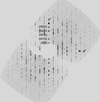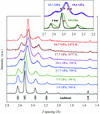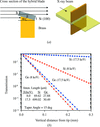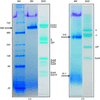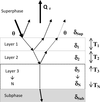issue contents
December 2008 issue

Cover illustration: Two-dimensional grazing-incidence X-ray scattering pattern for a PS-b-PI thin film deposited on a silicon substrate. Courtesy of Sangwoo Jin et al. [J. Appl. Cryst. (2007), 40, 950-958].
research papers
A new method for space-group determination is described that is based on a symmetry analysis of the scattering-density map resulting from the structure solution in space group P1.
A new technique based on X-ray powder diffraction has been developed for quantitative analysis of multiphase amorphous materials. The feasibility of the new method is demonstrated for an amorphous SiO2–poly(methyl methacrylate) hybrid nanocomposite.
Rietveld refinement based on in situ synchrotron X-ray powder diffraction data was combined with thermogravimetric analysis and mass spectrometry to study and compare the microstructural and structural changes of the initial layered double hydroxides and their decomposition oxides.
Single-crystal magnesium fluoride is useful as a short-wavelength epithermal neutron filter. The neutron attenuation coefficient has been measured at temperatures of 293 and 77 K.
The anatase-to-rutile transformation in photocatalytic titanias is reconstructive and proceeds via an abundant and persistent amorphous form that may enhance performance by creating higher surface area materials that also retard exciton recombination.
The statistical properties of X-ray intensities measured with counting systems were experimentally investigated by repeated measurements based on Chipman's foil method. It is shown that the observed statistical variance can be well reproduced by a formula derived from an intermediately extended dead-time model for counting loss.
A novel algorithm for orientation density function estimation from diffraction pole figures is presented which is especially well suited for sharp textures and high-resolution pole figures measured with respect to arbitrarily scattered specimen directions, e.g. by area detectors.
A computer-controlled method for the automatic mechanical centring of a powder capillary sample onto the rotation centre of a powder diffractometer, using total scattering of the radiation beam into one-dimensional or two-dimensional detectors and only a 90° rotation of the sample stage, is described.
The three-dimensional reconstruction program DAMMIN has been applied to time-resolved small-angle X-ray scattering data. The results are presented and their success in representing the molecules is assessed.
A three-dimensional DuMond formalism is proposed for a σ–π polarization geometry and a combined Bragg–Laue diffraction, and is employed to quantify the bending of single-crystal analysers.
Open  access
access
 access
accessHigh-resolution X-ray tomography is used to reconstruct three-dimensional volumes of vitrified macromolecular crystals.
The depth gradients of grain interaction and stress in Cu thin films were determined by X-ray diffraction stress measurements at fixed penetration depths. The effects of the surface roughness and the refraction of the incident beam were illustrated on the basis of a comparison of synchrotron and laboratory measurements, utilizing the corresponding variation in wavelength for tuning the absorption.
A methodology using synchrotron X-rays and two-dimensional detectors to study the mechanical properties of thin films is presented.
Download citation


Download citation


A strategy for improving the chances of solving molecular crystal structures from powder diffraction data using direct methods is outlined.
Open  access
access
 access
accessBy analyzing diffraction peak profiles at different P–T loading stages, the thermomechanical properties of materials can be derived, with graphical delineations of micro/macro yields, plastic flow, energy dissipation, work hardening/softening, grain crushing/growth, stress relaxation and residual strain, as well as instrument baselines for all diffraction modes.
A method for solving the direction of structural and microstructural perturbations using high-energy X-ray diffraction is demonstrated.
Open  access
access
 access
accessBy supplementing high-resolution X-ray powder diffraction data with information derived from precession electron diffraction data, increasingly complex structures of polycrystalline materials can be solved.
An investigation was conducted into the temperature and vibration profiles from a commercial cold-stream. Based on these results suggestions are made on how to align a cold-stream, the importance of cold-stream placement to minimize sample motion and how to look at data processing statistics to see if sample motion is affecting data quality.
A hybrid design consisting of a single-crystal tip bonded to a tapered metal base with a large tilt angle to the beam practically eliminates parasitic slit scattering in X-ray diffraction apparatus, leading to a single-aperture small-angle X-ray scattering instrument design with enhanced intensity and higher resolution.
Local axes systems are generated for multipole orientation in order to take the symmetry of the atoms fully into account.
Monodispersity obtained by the blue native PAGE (BN–PAGE) gel for membrane proteins correlates well with their propensity to crystallize. The results from BN–PAGE are more informative on the sample aggregation states in solution than other techniques such as dynamic light scattering and size exclusion chromatography. BN–PAGE is also particularly useful for efficient detergent selection for membrane protein crystallization.
teaching and education
Open  access
access
 access
accessA tutorial consisting of five macromolecular crystallography experiments has been assembled for teaching purposes. The described work comprises the crystallization of the proteins, diffraction data collection, data processing and automated structure determination.
computer programs
AutoSherlock is a program that visually represents results from the Hauptman–Woodward High-Throughput Crystallization Screening Service in chemical space. It thereby aids in the determination and further optimization of crystallization conditions.
It is shown that ExtSym can be used successfully with many well known powder diffraction analysis packages. In addition, a precise description of the optimal input for ExtSym is given to enable other software packages to interface with it.
A database linking (3 + 1)-dimensional superspace and three-dimensional space groups derived from real-space rational sections has been compiled and made available through a web-based application.
StochFit provides stochastic model-dependent and model-independent fitting routines for analyzing specular X-ray reflectivity data. Additionally, StochFit provides an intuitive and unique method of utilizing a model-independent fit to determine a model-dependent fit.


 journal menu
journal menu








